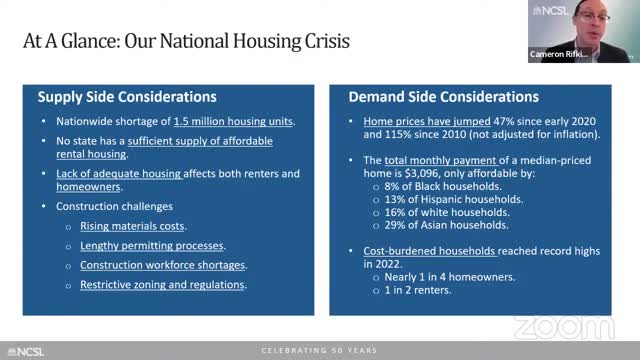Housing Crisis Deepens Amid Rising Costs and Regulatory Hurdles
August 26, 2024 | Housing, House of Representatives, Committees, Legislative, Connecticut
This article was created by AI summarizing key points discussed. AI makes mistakes, so for full details and context, please refer to the video of the full meeting. Please report any errors so we can fix them. Report an error »

In a recent government meeting, officials addressed the pressing housing crisis exacerbated by construction challenges, rising material costs, and lengthy permitting processes. A staggering 97% of developers reported delays in construction, with 83% attributing these setbacks to permitting issues. The meeting highlighted the alarming rise in home prices, which have surged by 47% since early 2020 and 115% since 2010, making homeownership increasingly unattainable for many. Currently, the median monthly payment for a home stands at over $3,000, affordable only for a small percentage of households across racial demographics.
The discussion underscored the record high of cost-burdened households, defined as those spending 30% or more of their income on housing costs, affecting nearly one in four homeowners and one in two renters. To combat these challenges, state housing policies are shifting towards incentivizing construction, expediting permitting processes, and revising zoning regulations to allow for increased density.
Key barriers identified include rising construction costs, workforce shortages, and restrictive zoning laws, which often limit land use to single-family homes. Approximately 75% of land is zoned exclusively for this type of housing, further constraining supply and driving up prices. However, opportunities for reform were also discussed, such as providing tax incentives for developers, streamlining permitting processes, and revising outdated building codes.
Several states have initiated legislative measures to address these issues. For instance, Alabama has introduced a workforce housing tax credit, while Maine has simplified its permitting process for affordable housing. Maryland and Montana are also taking steps to allow for more diverse housing types and reduce parking requirements, which can significantly increase development costs.
The meeting concluded with a call for continued collaboration among policymakers to create a more accessible and affordable housing landscape, emphasizing the need for innovative solutions to meet the diverse demands of current and future residents.
The discussion underscored the record high of cost-burdened households, defined as those spending 30% or more of their income on housing costs, affecting nearly one in four homeowners and one in two renters. To combat these challenges, state housing policies are shifting towards incentivizing construction, expediting permitting processes, and revising zoning regulations to allow for increased density.
Key barriers identified include rising construction costs, workforce shortages, and restrictive zoning laws, which often limit land use to single-family homes. Approximately 75% of land is zoned exclusively for this type of housing, further constraining supply and driving up prices. However, opportunities for reform were also discussed, such as providing tax incentives for developers, streamlining permitting processes, and revising outdated building codes.
Several states have initiated legislative measures to address these issues. For instance, Alabama has introduced a workforce housing tax credit, while Maine has simplified its permitting process for affordable housing. Maryland and Montana are also taking steps to allow for more diverse housing types and reduce parking requirements, which can significantly increase development costs.
The meeting concluded with a call for continued collaboration among policymakers to create a more accessible and affordable housing landscape, emphasizing the need for innovative solutions to meet the diverse demands of current and future residents.
View full meeting
This article is based on a recent meeting—watch the full video and explore the complete transcript for deeper insights into the discussion.
View full meeting
